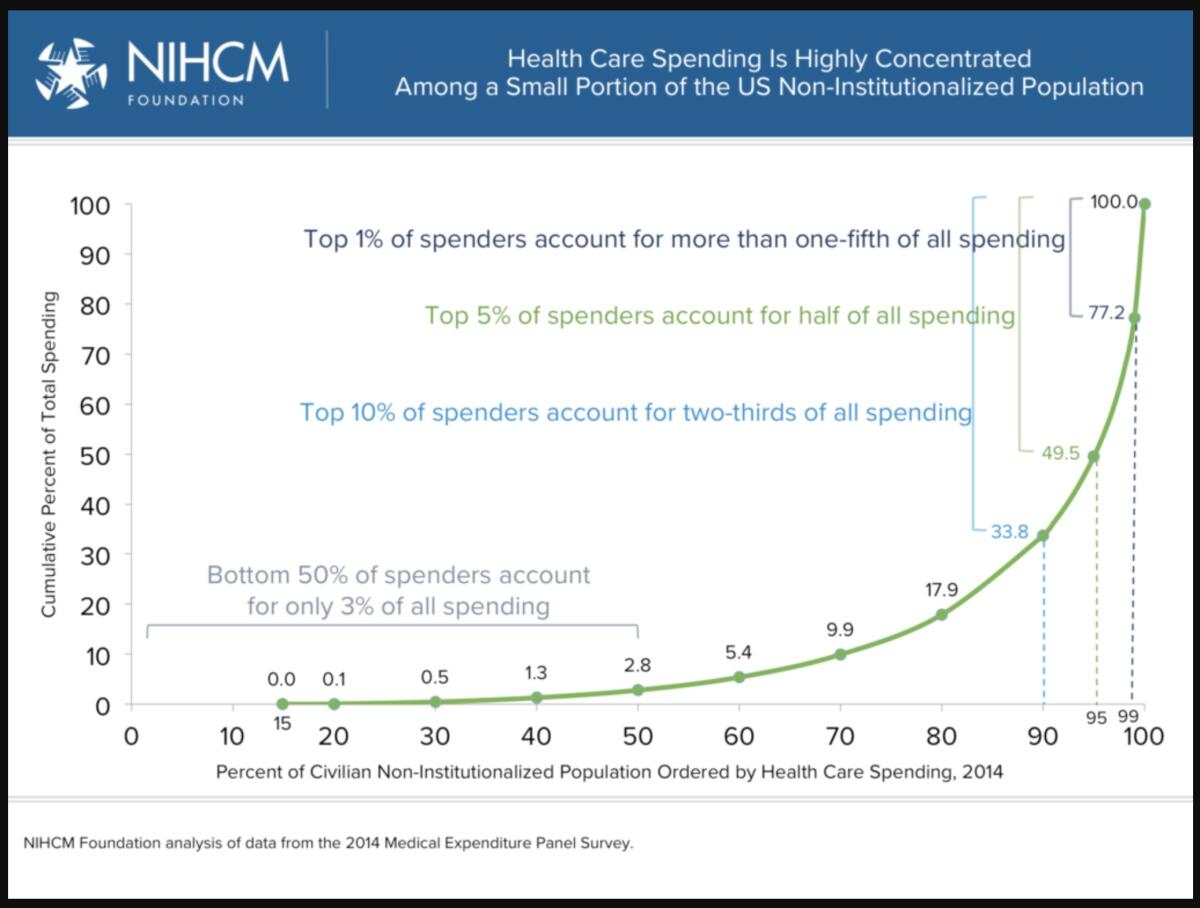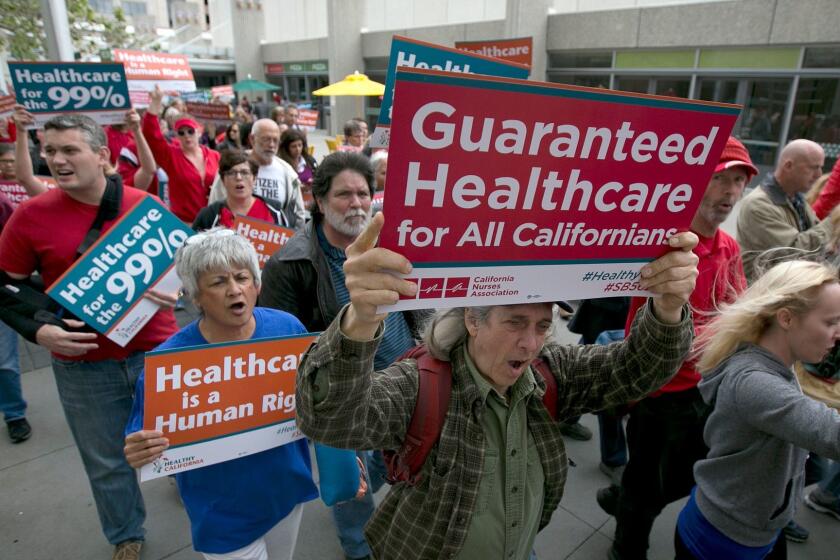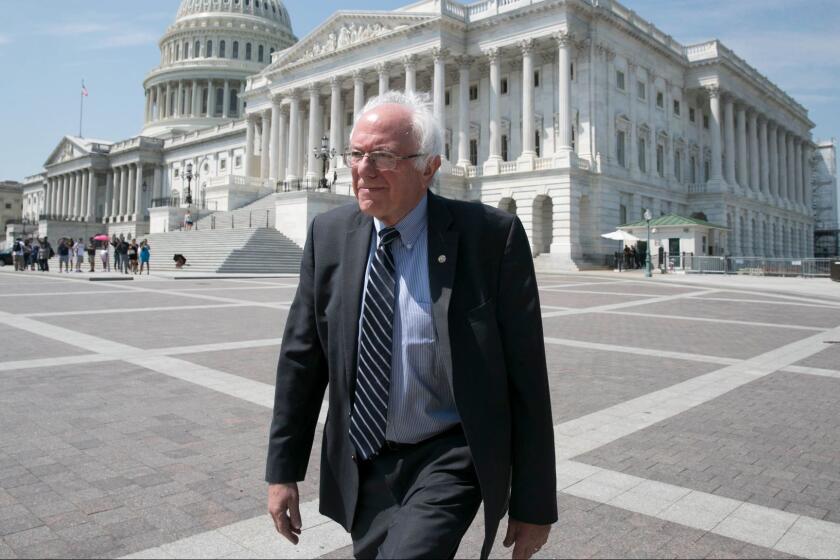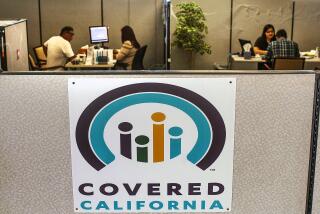Single-payer healthcare is the right system. Can California build it on its own?

- Share via
California, which has shown the determination to go it alone in areas such as environmental protection, scientific research and workers’ rights when its values conflict with policies at the federal level, is moving forward with its most audacious effort yet.
That’s a plan to create a universal single-payer healthcare system.
Called CalCare, the program would take over health coverage for more than 40 million residents from government policies such as Medicare and Medicaid and from private plans whether sponsored by employers or purchased through the Affordable Care Act marketplace.
We can’t have that cost containment ability without having the massive bargaining power of every single Californian.
— Carmen Comsti, California Nurses Assn.
This would mean placing $400 billion in annual expenditures in the hands of a state governing board. Say goodbye to the dead hand of private health insurers, to navigating in-network and out-of-network charges, to deductibles and co-pays, to substandard dental, vision and hearing services. Every resident of the state, regardless of where they get their coverage now, would be eligible for the new system.
At least, that’s the promise. Whether the Legislature will be able to bring this idea to fruition is anyone’s guess.
Get the latest from Michael Hiltzik
Commentary on economics and more from a Pulitzer Prize winner.
You may occasionally receive promotional content from the Los Angeles Times.
Under its rules, the measure embodying the program, AB 1400, must be sent by Jan. 31 from the Assembly to the Senate, where it is likely to be masticated into the summer. The proposal, like its several predecessors introduced in recent years, is sponsored by the California Nurses Assn.
Not a few Assembly members have already expressed skepticism, but it’s a bit early to pull the plug. I agree with my colleague George Skelton that this is “a debate worth having.”
But it’s not a debate coming out of the blue. Indeed, it is sure to have a heavy component of déja vu. California has tried to enact a universal single-payer program many times in the past. Each time, it foundered over concerns about its cost and opposition from politically potent interests such as the commercial insurance industry and the California Medical Assn.
In 2018, for instance, a proposal almost identical to AB 1400 was torpedoed by Assembly Speaker Anthony Rendon (D-Lakewood). The uproar his action generated, however, forced him to establish a legislative committee to examine how to achieve universal health coverage in the state.
The 2018 proposal, like the new version, would have taken over responsibility for almost all medical spending in the state while relieving employers, their workers and buyers in the individual market of premiums and out-of-pocket expenses.
Private health insurers contribute nothing to healthcare except costs. It’s time to throw them out.
In both versions, California residents would be eligible to obtain treatment from any licensed doctor in the state. Insurance companies would be barred from replicating any services offered by the program.
Many of the details of the system would be subject to further discussion in the Legislature and ultimately subject to policies set by a nine-member governing board appointed by the governor and Legislature.
It has always been clear that a single-payer program would help to relieve some of glaring deficiencies of the U.S. healthcare system. It would relieve doctors and hospitals of the need to employ brigades of billing clerks to chase down reimbursements from insurers.
It would give the single payer the leverage to control prices through negotiation and provide consistent standards governing the suitability of treatments. It would relieve consumers of the perplexity involved in selecting an insurance plan that doesn’t exclude the doctors they need to manage their conditions.
A couple of things have changed since 2018 that should give a single-payer plan additional luster in California. For one thing, the state casts an ever-bigger fiscal footprint. Then, the state had a population of 39 million; now it tops 40 million. Then, the state’s gross domestic product was about $2.6 trillion; today it’s more than $3 trillion.
Another factor is COVID-19. As UC San Francisco associate professor of medicine Rupa Marya observed in a recent op-ed in The Times, “the pandemic provides a powerful case study on the need” for a universal system. Most private insurers are no longer waiving cost-sharing for COVID treatment, “leaving even insured and vaccinated patients with potentially astronomical bills,” she warned.
“Without coverage like CalCare, this will be a recipe for the virus to go untreated or for patients to face financial ruin,” Marya wrote.
California Assembly Speaker Anthony Rendon may have expected to torpedo the idea of a statewide single-payer healthcare system for the long term last June, when he blocked a Senate bill on the issue from even receiving a hearing in his house.
The big numbers being thrown around by critics to scare people about the cost of a California single-payer plan are misleading. That’s because they tell only part of the story, like eavesdropping on only one end of a telephone call. The GOP’s legislative caucus says a single-payer system in California would cost $400 billion and require $163 billion annually in new taxes.
The new taxes don’t necessarily represent new spending, however. They would substitute for what California’s government, residents and employers spend now. The fundamental question is how thoroughly the substitution would cover existing costs.
The answer depends on several factors. One is how successful California’s new system would be at reducing costs. The proposal’s sponsors say that the state is uniquely well-positioned to extract the billions in savings by negotiating with drug companies, hospitals and physician groups.
That’s plausible. Through a universal single-payer program, California would present providers with a massive ready-made market — fully 10% of the entire United States.
You want to play in this market, you’ll have to come to the table; the only question is how adept the state’s negotiators might be at extracting the maximum discounts. Tying provider reimbursements to Medicare rates, as is proposed in AB 1400, would produce cost reductions of as much as 40% compared with reimbursements paid by private insurers.
“We can’t have that cost containment ability without having the massive bargaining power of every single Californian,” says Carmen Comsti, lead regulatory policy specialist for the California Nurses Assn. “It’s as if we’re asking the CalCare system to be our collective bargaining representative with hospitals and doctors.”
The nurses association says the system would cost less overall than is currently spent on healthcare in the state. “We would get more, cover everyone and pay less,” Comsti said in testimony Jan. 11 to the Assembly Health Committee.
Responding to my post about how the Supreme Court’s Hobby Lobby ruling demonstrates the necessity of a single-payer healthcare system, Ezra Klein raises the specter of unrestrained political interference in healthcare decisions.
The nurses association and Assemblyman Ash Kalra (D-San Jose), who is carrying the legislation in the lower chamber, have tried to finesse the cost issue this year by bifurcating the single-payer proposal into an authorizing measure, AB 1400, and a separate constitutional amendment, ACA 11, providing for the system’s financing.
Their goal is to pass the first to establish the single-payer principle in state law and put off the second until after the state secures all the federal waivers necessary for its takeover of federal programs such as Medicare and Medicaid, which is known in California as Medi-Cal.
As currently drafted, the financing amendment calls for financing the program through a business tax of 2.3% of gross receipts over $2 million a year; a payroll tax of at least 1% on wages above $49,900 per employee; and an income tax increase starting at 0.5% of income over $149,509 and up to 2.5% on income over $2.48 million.
You’ll hear antitax agitators squealing that California already levies the highest state taxes in the nation. Of course, if the program comes to fruition, California would be the only state to outlaw health plan premiums, deductibles and copays and to guarantee health coverage to all.
An analysis of an earlier version in 2017 performed at the University of Massachusetts found that with a combination of a 2.3% gross receipts tax and a 2.3% increase in the sales tax, money would be saved by businesses across the board and by all households except for the highest-earning 20%, with income starting at $227,600 that year.
Republicans in Sacramento cast further doubt on the state’s takeover of health coverage by arguing that Democrats have “proven themselves incapable of simple things like building a railroad, providing clean drinking water, keeping the lights on and filling potholes,” in the words of Assembly Republican Leader Marie Waldron of San Diego County.
That’s essentially cherry-picking. The best model for the state’s oversight of healthcare is Covered California, our Affordable Care Act exchange.
With Republicans seeming to have abandoned their repeal-or-bust attack on the Affordable Care Act, the path to improving Americans’ health coverage is wide open.
Covered California’s approach of actively supervising health insurance carriers in the individual market not only has worked exceptionally well but also is arguably the most successful ACA exchange in the country — and has helped bring down the level of uninsured Californians to about 6% from more than 17% in 2013.
As much as Republicans want to cavil about the efficiency of state government, the truth is that the healthcare system in place now is the very antithesis of effectiveness and efficiency.
Medicare works well as far as it goes, but the holes in its coverage force beneficiaries to purchase separate “Medigap” policies or sign up for Medicare Advantage plans, which consistently overcharge the government for their services. Nor is it capable of expanding beyond its traditional base of consumers over 65, without radical reform.
Private insurers boast of their ability to control costs and extract efficiencies from providers, but they’ve never delivered on that claim, even as they underwent a wave of mergers they said would create mega-carriers with the leverage to demand lower prices.
They suppress spending less by applying rational standards to treatment protocols than by erecting roadblocks to discourage enrollees from accessing the services they need. They are now, and always have been, profit-seeking entities, and the profits come out of their customers’ hides.

It’s well understood that the obstacles to enacting single-payer health coverage in California, as in the country as a whole, arise less from policy than from politics.
One obstacle is the notion that people are happy with their existing health coverage. As I’ve observed in the past, this is mostly a mirage. To put it more accurately, most people are complacent about their coverage, for the simple reason that the vast majority of Americans don’t have complicated interactions with the healthcare system through most of their lifetimes. It’s an immutable truism in healthcare that the top 5% of all patients account for half of all spending, and the bottom 50% account for only 3% of spending.
Broken bones, pregnancies, even cardiac events are routinely managed by the system in a way that’s good enough for the 49% of Americans who receive care through their employers. For them too, the ridiculously inflated costs are largely invisible, buried in their employers’ share of premiums.
It’s on the margins, however, where the system breaks down. “A lot of people with really, really lousy health insurance didn’t know it because they never had to use it,” healthcare commentator Jonathan Cohn told me last year. “If they did get a tragic healthcare problem — a car accident, or cancer, or a child with a congenital problem — for the first time they have to use their health insurance and now they’re discovering what it doesn’t cover.”
The problem of uninsured and underinsured Americans is also largely invisible to those with coverage, but it should be a concern for everybody. Healthcare is a communal benefit, undermined by the inequities that deprive too many Americans and too many Californians of access to healthcare.
Nothing illustrates the risks to the entire community of the difficulty we’ve had in fighting the pandemic, thanks to the determined efforts of anti-vaccine crusaders to push policies that leave millions of Americans exposed to the virus and encourage its spread.
CalCare would address those marginal but significant costs. Yes, it would be audacious, but in the context of a country in which healthcare reform has stagnated and compared with states that appear resolved to move backward in their standards of public health, it could be another policy to make Californians proud.
More to Read
Get the latest from Michael Hiltzik
Commentary on economics and more from a Pulitzer Prize winner.
You may occasionally receive promotional content from the Los Angeles Times.















